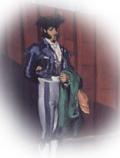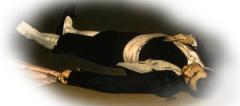 Edouard Manet was thirty-two when the Incident in a Bullfight was exhibited and still in the early stages of his relatively brief career, which was cut short by an untimely death at fifty-one. revered today as one of the great innovators in the history of art, he belongs to no one school, although he has been allied with the Realists and Impressionists. His radical innovations--flattening of the picture space, daring luminous effects, and simplifications of painting technique--as well as his contemporary urban subject matter, have led him to be regarded as the father of Modernism. Edouard Manet was thirty-two when the Incident in a Bullfight was exhibited and still in the early stages of his relatively brief career, which was cut short by an untimely death at fifty-one. revered today as one of the great innovators in the history of art, he belongs to no one school, although he has been allied with the Realists and Impressionists. His radical innovations--flattening of the picture space, daring luminous effects, and simplifications of painting technique--as well as his contemporary urban subject matter, have led him to be regarded as the father of Modernism.
 The Incident was the first and largest of several paintings on the bullfight theme that Manet executed in the mid 1860's. It was shown at the Salon of 1864, provoking a storm of criticism and public hilarity. Manet's critics thought the painting was incomprehensible and were disturbed by his handling of the perspective, especially the size of the bull.
Manet had trouble working out the composition from the beginning. One reason was that he had never seen a bullfight. The Incident was the first and largest of several paintings on the bullfight theme that Manet executed in the mid 1860's. It was shown at the Salon of 1864, provoking a storm of criticism and public hilarity. Manet's critics thought the painting was incomprehensible and were disturbed by his handling of the perspective, especially the size of the bull.
Manet had trouble working out the composition from the beginning. One reason was that he had never seen a bullfight.
 Soon after the painting was rejected by the Salon, Manet cut up the canvas. He subsequently reworked each of the pieces, developing them into independent paintings, and presumably discarded the rest of the canvas. The Dead Toreador comprises most of the lower two-thirds of the original composition, was exhibited to critical acclaim, and became one of his most famous works. The Bullfight is the upper right hand piece and is less well known. Soon after the painting was rejected by the Salon, Manet cut up the canvas. He subsequently reworked each of the pieces, developing them into independent paintings, and presumably discarded the rest of the canvas. The Dead Toreador comprises most of the lower two-thirds of the original composition, was exhibited to critical acclaim, and became one of his most famous works. The Bullfight is the upper right hand piece and is less well known.
 Manet left no record of the Incident of a Bullfight as it appeared at the Salon. The following is a result of The National Gallery of Art and
The Frick Collection coming together to study the fragments of the painting. Manet left no record of the Incident of a Bullfight as it appeared at the Salon. The following is a result of The National Gallery of Art and
The Frick Collection coming together to study the fragments of the painting.
 Enter the review HERE to to learn about the lost fragments. Enter the review HERE to to learn about the lost fragments. |



